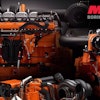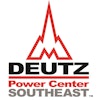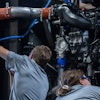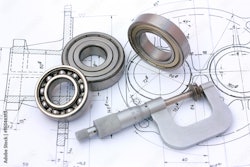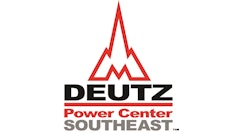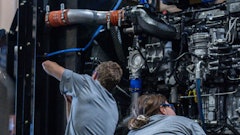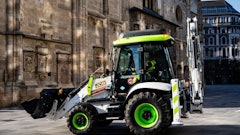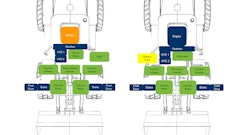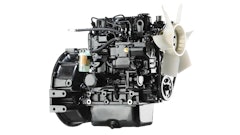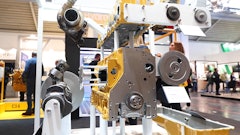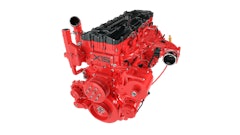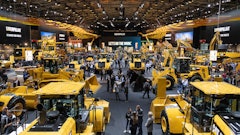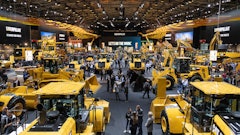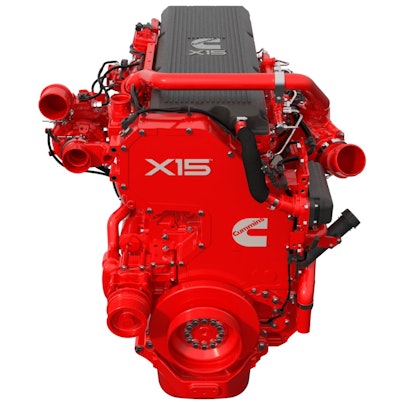

In this Q&A, Harsin discusses the future of engines, including alternative fuels, the need for engine and fueling infrastructure and the desire for the off-highway world to be greener.
Internal combustion engines will remain a vital means of supplying power in heavy-duty applications for the foreseeable future. How will Cummins continue to evolve and advance its engine designs?
Cummins has always invested in future technology and met or exceeded emissions regulations and will continue to do so. We will continue to invest in our global platforms, leveraging cross-market scale to bring the best products to OEM customers. Diesel investments in the next decade will play a strong role in the effort towards a cleaner future. Cummins also continues to invest in alternative fuels and powers (such as electric and hydrogen).
It is also worth noting that, with diesel internal combustion engines (ICE), it is possible to see increased usage of biofuels such as HVO100. Pockets of this are happening already today. Currently, some of the Cummins off-highway engines are approved for B20 diesel and paraffinic fuel.
How does Cummins see emissions regulations for off-highway equipment progressing? What might a Tier 5 regulation in the U.S. look like, and how will that or other future regulations impact engine system designs?
Cummins has the benefit of being a global company, so we already produce and sell engines that meet the Stage V European emissions regulations and are actively investing in upcoming on-highway emissionized products. Cummins has an excellent engineering team and will meet or exceed any new regulations that may come to be in the US. High-quality engineering capabilities coupled with a strong automotive-based technology portfolio have us well-positioned for any number of regulatory scenarios.
Engine Fuel Sources
It has been made clear that a variety of power sources will be necessary to meet heavy equipment performance demands while lowering emissions. What are the top two or three technologies that you see being most beneficial to meet these requirements in the near term?
While we still see diesel as the main power source in the near future for construction, there will be certain applications that can benefit from mixed-power options more easily than others. It is not a one size fits all approach.
When you talk compact construction, while still limited by infrastructure availability outside certain settings, there has been a trend for electrification. Adoption rates in the next 5 to 10 years, again outside some specific market settings, are likely to remain low with the rate decreasing as equipment size increases. Hydrogen is also emerging as an alternative fuel of interest, either in fuel cell or spark ignited form. Similar to electrification, the hydrogen infrastructure will also take time to develop. Packaging hydrogen on a machine requires a different process than installing a diesel engine, and it will take time to ensure that is done well. As has been seen with electrification, there will probably be pockets that adopt, highlighting the fragmented nature and diversity of the off-highway market. Metal machinery is not easily redesigned, particularly thick metal like what is found on construction equipment. It is likely that OEMs will delay the investment of full machine redesign in many cases until the adoption picture becomes clearer, meaning there could be a period before optimized alternative power chassis are available.
Looking specifically at battery power systems, what are the biggest benefits you see currently with that technology. What are some of the hurdles that have yet to be overcome, and what might the future be for this technology?
Cummins is already moving into its third generation of battery development building on previous generations of learnings and developments. This stuff turns fast. Cummins is investing heavily in battery technology across several key markets and applications along with investment into different battery technologies.
Building on early adopting technologies, market pull and in house testing allows Cummins battery technology to stay at the forefront of development. Our latest battery packs and battery modules can be integrated expertly with the Cummins electric and hybrid powertrain portfolio. These flexible, scalable power solutions for small and large commercial applications are backed by the quality and support of Cummins.
As a basic guide, I’d say small compact equipment electric vehicles will eventually dominate where infrastructure supports the movement. With medium-duty construction equipment, it is likely that electric and some form of hydrogen technology will coexist. As equipment sizes increase, we’d more expect hydrogen to win out and be supported by batteries in a hybrid state. This won’t be a hard-and-fast rule but is a reasonable, simplified view for the portion of the market that does migrate from diesel.
Hydrogen Power
Similarly, where is the industry, or Cummins specifically, at with hydrogen powered systems? What are some of the current hurdles, and what might be some future opportunities?
Cummins is actively investing in hydrogen technologies for both powertrain and infrastructure. The same as other non-diesel technologies, for most construction equipment, it is hard to see a pure total cost of ownership payback in the near term. There will continue to be pockets that adopt, many of which will be great test beds as the technology matures. As the infrastructure to obtain hydrogen matures, this technology will continue to draw increased levels of interest.
Technology wise, we have the capability to power equipment today. You should think of a fuel cell as a “battery that generates its own electric.”
Fuel cells work alongside other battery technology in a hybrid setup. The battery is instantaneous, providing high power for a short period then the fuel cell comes in.
The fuel cell sucks in oxygen from the air to create a reaction, turning the hydrogen into electricity. The time delay for this to happen is managed by a battery. Both the battery and fuel cell feed power to the electric motor in parallel. The battery size and fuel cell depend on the duty cycle of the vehicle/machine and integration expertise is very important to specify the right solution.
Cummins’ expertise will define how these are “stacked.” The same mentality as engine systems is used: radiator, fan, air intake. Accessories, pumps etc. will be provided by Cummins as a package. Total package/solutions including NPROXX tanks. Filtration of air is very important.
A fuel-cell/hybrid-system experience will be the same as diesel, mirroring the strengths of combustion engines in range and capability and adding the zero emissions strength of batteries.
How might hydrogen-fueled engines be used going forward? What is yet needed to make them more market-ready?
No doubt folks have seen some of the recent press activity around the work Cummins is doing in this space. Cummins recently received a grant from the U.K. government to help fund the development of medium-duty and heavy-duty engines that run on hydrogen. Hydrogen ICE is a technology we are really excited about.
The cool thing about hydrogen ICE, circling back around to that notion of scalability I talked about earlier, is that it offers the opportunity to have a platform approach with diesel where a fair amount of the basic hardware is fuel agnostic. Obviously, the top end of the engine, spark ignition, fuel system & controls are different from diesel. However, the base crankshaft, block, and even some aftertreatment components could see automatic scale benefits from the diesel space. The other cool thing about the hydrogen combustion engine is it matches well with the fuel cell products when you think about the hydrogen storage and generation parts of the system.
A hydrogen ICE offers the equipment industry a great opportunity to decarbonize without wholesale redesigns to existing powertrains. While packaging the onboard hydrogen is not insignificant, being able to maintain consistency on the chassis side from the flywheel back is a great way to rationally approach zero emissions.
Looking to the Future
If you had to encapsulate, what does the future look like for heavy-duty off-highway equipment power systems?
The desire to be greener resonates strong in the off-highway world. Corporate initiatives and responsibility aspirations are generating activity and prompting a lot of thought. Despite the obvious challenges I just spoke of, nearly all the major players in the construction equipment world are talking about what their zero or near-zero solutions will be, some even offering commercially available products. An important distinction here is that I said commercially available, which doesn’t necessarily mean commercially viable yet. In most if not all cases, there is a price premium to be green for end consumers unless there are purchase incentives or tax breaks available.
Overall, I would expect high levels of market interest in alternative technologies that will be throttled by the infrastructure required to operate. The infrastructure needs to mature to make scalability possible, which will in turn bring down technology costs for end users. Pocketed adoption will happen, likely in site-centric populations where the early investments make the most sense. Luckily, we believe diesel is far from done with a promising, infrastructure-supported, and cost-effective road ahead!
Read the PowerBook now.

